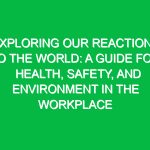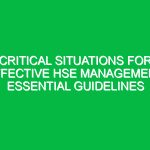Understanding Tripping Hazards in the Workplace
Tripping hazards are defined as any object or condition that poses a risk of causing individuals to lose their balance and fall. In the context of Health, Safety, and Environment (HSE), addressing tripping hazards is crucial as they can lead to significant injuries, decreased productivity, and increased costs for businesses. According to the Occupational Safety and Health Administration (OSHA), slips, trips, and falls account for a substantial portion of workplace injuries. This article aims to provide comprehensive insights into tripping hazards, their implications in the workplace, and effective strategies to mitigate these risks.
The Relevance of Tripping Hazards in the HSE Context
Tripping hazards are not merely an annoyance but a serious safety concern that can compromise the well-being of employees. In various industries, from construction sites to office environments, the potential for tripping hazards exists. For instance, an employee in a warehouse may trip over a poorly placed pallet, while in an office, someone might stumble over a loose carpet edge. The consequences of such incidents can range from minor injuries, such as sprains and bruises, to severe injuries, including fractures or head trauma.
Moreover, addressing tripping hazards is vital for compliance with HSE regulations. Organizations can face legal liabilities and financial penalties if they fail to maintain a safe working environment. The proactive management of tripping hazards not only protects employees but also fosters a culture of safety that can enhance overall organizational performance.
Common Tripping Hazards in the Workplace
Identifying common tripping hazards is the first step in mitigating risks. Below are some typical hazards found in various work settings:
- Poorly Maintained Flooring: Uneven surfaces, cracked tiles, or worn-out carpets can easily lead to trips.
- Obstructed Walkways: Items such as tools, boxes, or even furniture left in walkways can create tripping risks.
- Cables and Wires: Exposed electrical cords or cables running across walkways are notorious for causing falls.
- Inadequate Lighting: Poorly lit areas can obscure hazards, making it difficult for employees to navigate safely.
- Weather Conditions: Rain, snow, and ice can create hazardous conditions outside of the workplace.
Recognizing these hazards is essential for implementing effective safety measures.
Best Practices for Avoiding Tripping Hazards
To minimize the risk of tripping hazards in the workplace, organizations should adopt a proactive approach. Here are some essential tips:
1. Conduct Regular Inspections
Regular workplace inspections can help identify potential tripping hazards before they cause accidents. Set a schedule for routine checks of walkways, work areas, and common spaces. Encourage employees to report any hazards they encounter immediately.
2. Maintain Clear Walkways
Ensure that all walkways are kept clear of obstacles. Implement a “clean-as-you-go” policy in areas prone to clutter. This could mean designating specific areas for tool storage and ensuring that floors are free of debris.
3. Improve Lighting
Proper lighting is crucial for helping employees navigate safely. Invest in adequate lighting solutions for all areas, especially staircases, hallways, and entrances. Consider motion-sensor lights in less frequently used areas.
4. Use Non-Slip Flooring
Select flooring materials that offer better grip and traction. Non-slip mats can be particularly beneficial in areas prone to spills or moisture. Regularly inspect and replace worn mats to maintain their effectiveness.
5. Mark Hazards Clearly
Use clear signage to indicate potential hazards, such as steps or changes in elevation. Brightly colored tape can also be used to highlight tripping hazards, making them more visible.
6. Implement Training Programs
Training employees to recognize and mitigate tripping hazards is vital. Conduct safety training sessions that cover the importance of maintaining a safe workspace and how to identify potential hazards. Encourage a culture of safety where employees feel empowered to report hazards.
7. Address Weather-Related Hazards
Implement protocols for inclement weather conditions. For example, ensure that walkways are promptly cleared of snow and ice, and use salt or sand to enhance grip. Provide employees with appropriate footwear for slippery conditions.
Real-Life Examples of Tripping Hazards
Understanding tripping hazards through real-life examples can highlight their impact effectively. Consider the case of a factory worker who tripped over a loose cable that had not been secured. The fall resulted in a broken wrist, leading to costly medical bills, lost wages, and decreased productivity. The incident could have been prevented with proper cable management and regular safety checks.
In another scenario, an office employee tripped over a stack of boxes left in a hallway during a busy moving day. This incident not only caused injury but also disrupted workflow. Organizations must cultivate a culture in which employees prioritize workplace safety and understand their role in preventing hazards.
Regulations and Standards Governing Tripping Hazards
Compliance with specific regulations and standards can significantly impact the management of tripping hazards. In many regions, regulations set by OSHA and similar bodies outline requirements for maintaining safe workplaces. For example, OSHA‘s General Duty Clause mandates that employers provide a work environment free of recognized hazards that could cause death or serious physical harm.
Additionally, industry-specific guidelines may exist to address particular hazards. For example, the National Fire Protection Association (NFPA) has standards that may influence the layout of workplaces to prevent tripping hazards related to emergency exits.
Conclusion
In summary, tripping hazards pose a significant risk to workplace safety, impacting not only employee well-being but also organizational performance. By recognizing common hazards, implementing best practices, and adhering to regulatory standards, organizations can create a safer work environment.
Promoting health and safety in the workplace is not just a legal obligation but a moral one. It fosters a culture of care and responsibility, encouraging employees to be vigilant about their surroundings. As we continue to navigate the complexities of modern workplaces, addressing tripping hazards must remain a priority. Organizations should take proactive steps to ensure that safety measures are not only in place but are also actively enforced. By doing so, they can contribute to a healthier, more productive work environment for everyone involved.


